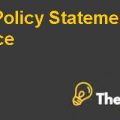JetBlue Case Case Study Help
Introduction
JetBlue, a prominent player in the aviation industry, is at a critical juncture as it contemplates two distinct financing proposals to raise additional capital. Faced with the choice between an equity offering and a private placement of convertible debentures, the airline's Chief Financial Officer, Owen Kelly, grapples with the implications of each alternative on the company's capital structure and investor profile. As JetBlue aims to secure funds for its strategic expansion plans, the decision holds far-reaching consequences for its financial stability and market positioning.
This case delves into the financial intricacies surrounding the proposed equity offering and convertible debenture issuance, exploring the potential impact on JetBlue's capitalization, cost of capital, and overall financial health. Against the backdrop of historical financial data and market conditions, the analysis seeks to guide JetBlue in making an informed and strategic financing decision that aligns with its long-term business objectives. (Nabil N. El-Hage, 2007)
Problem Statement
With historical financial data indicating a mix of revenues and expenses, and the aviation industry's dynamic nature, JetBlue seeks to optimize its financing strategy to support strategic expansion plans. The challenge lies in determining which proposal aligns best with JetBlue's long-term growth objectives, maintains a balanced capital structure, and ensures cost-effective capital raising. (Stewart, 2008)
Situational Analysis
Key Challenges
Investor Appetite and Strategic Alignment: JetBlue is at a crossroads, grappling with the challenge of identifying financing alternatives that align with its strategic goals while appealing to investors. The dilemma of whether to opt for equity offering or convertible debentures raises questions about the company's relationship with its existing private equity backers and the broader market's appetite for each security type.
Financial Structure Optimization: Balancing the financial structure to ensure an optimal mix of equity and debt is a key challenge. JetBlue needs to evaluate the impact of each financing alternative on its debt-to-equity ratio, considering the long-term implications for financial stability, cost of capital, and the ability to fund future expansions.
Market Conditions and Investor Perception: The aviation industry is inherently sensitive to market conditions and investor sentiment. JetBlue faces the challenge of gauging how investors, particularly those who were part of the company's initial private equity phase, will respond to a new round of financing. Ensuring that the chosen alternative is well-received and does not unduly dilute existing shareholders' value is paramount. (Flouris, 2007)
Cost of Capital Dynamics: The cost of capital is a critical factor in the decision-making process. JetBlue must carefully assess the implications of each financing option on its Weighted Average Cost of Capital (WACC) to determine the most cost-effective approach. Striking a balance between minimizing the cost of capital and meeting the company's financial requirements is a challenging task.
Long-Term Viability and Growth: The financing decision should not only address immediate capital needs but also contribute to JetBlue's long-term viability and growth. Ensuring that the chosen alternative provides the necessary resources for fleet expansion, facility construction, and working capital, while also supporting sustained profitability, is a multifaceted challenge.
Convertible Debenture Complexity: Opting for convertible debentures introduces complexity with terms such as conversion price and maturity date. JetBlue faces the challenge of structuring these debentures in a way that attracts investors while managing potential dilution effects and ensuring a favorable long-term financial outlook.
Dynamic Regulatory Environment: The aviation industry operates in a dynamic regulatory environment. JetBlue must navigate regulatory challenges associated with both equity offerings and convertible debentures, ensuring compliance while also considering how regulatory changes might impact the chosen financing structure.
Macroeconomic Uncertainties: External factors, such as macroeconomic conditions and geopolitical events, introduce uncertainties that can impact the aviation industry. JetBlue faces the challenge of making financing decisions that account for these external variables, safeguarding the company against unforeseen challenges.
Addressing these key challenges requires a comprehensive understanding of JetBlue's financial landscape, industry dynamics, and investor expectations, ensuring that the chosen financing alternative aligns with the company's strategic objectives and paves the way for sustained success in a competitive market.
Key Financing Alternatives for JetBlue
Equity Offering:
JetBlue could pursue an equity offering by issuing 2.6 million shares at an estimated price of $42.50 per share, aiming to raise $110.5 million in capital. This approach involves selling ownership stakes to new and existing shareholders, infusing the company with immediate funds.
Advantages:
- Equity offerings do not create additional debt obligations, contributing to a more favorable debt-to-equity ratio.
- Provides an opportunity to attract new investors and align with those seeking ownership in the company.
Challenges:
- Potential dilution of existing shareholders' equity.
- Market perception and reaction to the equity issuance may impact shareholder confidence..........
- JetBlue Case Case Study Help
This is just a sample partial case solution. Please place the order on the website to order your own originally done case solution.













